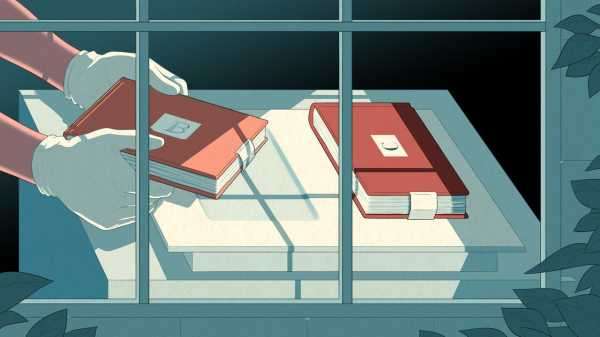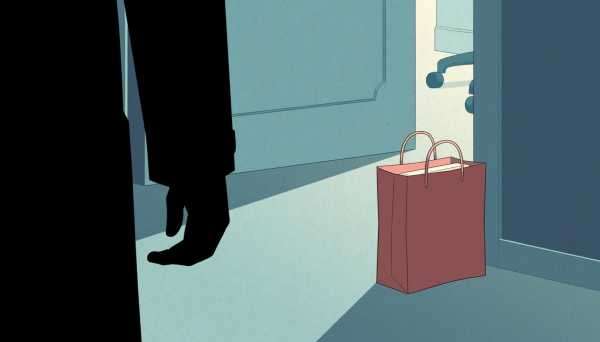
In a dimly lit basement in the Cambridge University Library, a conservator recently removed two reddish-brown, leather-bound notebooks from a moisture-controlled glass display case. The notebooks—one labelled “B” and the other “C”—belonged to the nineteenth-century naturalist Charles Darwin. In the spring of 1837, while wandering the filthy streets of London fresh from a five-year world-spanning expedition, he filled their pages with brilliant thoughts and dreadful drawings. (Darwin’s famous tree-of-life sketch, which appears in notebook “B,” looks like a schoolboy’s idle doodle.) The ideas that he jotted would later bloom into theories about the origin of species, which makes the notebooks akin to scientific relics.
For academics, the uncooked contents of the notebooks represent some of the liveliest writing in biology. “A lot of Darwin’s prose feels quite Victorian,” the professor Jim Secord, a leading expert in Darwin’s correspondence, told me. “But these are different: an early form of stream of consciousness; like Leopold Bloom on steroids.” Secord, who is sixty-nine and has the restrained charm of an American who has worked for decades in English academia, first saw the notebooks soon after he began teaching at Cambridge, in 1992. He examined the artifacts a few times in subsequent years, an experience that brought the reality of Darwin’s experience to life.
Then, in September, 2000, the notebooks were removed from the Special Collections Strong Rooms—where the library’s rarest and most valuable items are kept—to be photographed. At that time, the library was laxer about security; the shoot took place in a portable building situated on the library grounds. According to the logbook entries that record the comings and goings of library objects, the notebooks were duly returned. But, three months later, during a routine stock check, staff discovered that they were missing. “My theory was that they had been swept into a wastepaper basket,” Secord said. “That obviously turned out to not be true.”
For two decades, the library staff chose to believe that the notebooks, which are worth several million dollars apiece, had been misplaced—a somewhat reasonable theory considering the Alexandrian scale of the library’s collection of approximately eight million books spread across more than two hundred kilometres of shelving. With each passing year, however, the theory weakened. “People with legitimate interests had started to say, ‘Hey, we’d really like to see the notebooks,’ ” Secord explained. “And, if a newspaper had got a hold of the story, and reported that their loss had been kept secret . . . You know, it would really be bad.”
In April, 2017, Dr. Jessica Gardner became the university’s head librarian. She soon learned about the missing notebooks, whose loss was known to only a few. Discovering their whereabouts became a priority. Gardner sought advice from the national-security adviser for the Arts Council England and an expert with the Metropolitan Police and others who have worked on high-profile cases of cultural theft around the world. The message was consistent: “Go public.” In November, 2020, the university came clean, publishing a description of the notebooks and the presentation case in which they had been kept; Interpol was informed.
Sixteen months later, on March 9th, at around eight in the morning, Gardner arrived at her office on the fourth floor of the library’s seventeen-story main tower to begin a string of Zoom meetings. At this time, the library’s head of communications, Stuart Roberts, would typically be making his morning cup of tea in the kitchen across the corridor from Gardner’s office, but that day a doctor’s appointment made him late: “A bit of a bugger,” he said.
When Gardner’s personal assistant, who has chosen to remain anonymous, arrived at half past nine, she spied a bright-pink gift bag on the floor outside the librarian’s office, an area surveyed by a couple of seventeenth-century oil portraits but, at the time, no CCTV camera. There was a large brown envelope inside the gift bag and a card that read, “Librarian. Happy Easter. X.” Believing it to be a present for her boss, the assistant took the package to Gardner’s office. A little while later, she checked the parcel again and realized it was something else entirely.

Illustration by Anuj Shrestha
For five days, Cambridgeshire police conducted tests on the packaging. Secord was at home when the authorities returned the notebooks to the library. He took a call from the deputy director for research collections, who said, simply, “They’re back.” The deputy asked Secord, who claims that he can occasionally identify nineteenth-century newspapers by font alone, to offer an initial appraisal. Secord raced to the library. “They looked like the real thing,” Secord recalled thinking. “I mean, what forger would have known how the metal clasps were slightly decayed?” While Darwin was alive, he removed some of the pages from the notebooks, to be filed elsewhere, so archival experts in the University Library checked that no additional pages had been kept by the thief as a memento. None were missing. Still, Secord remained professionally guarded, concerned that he might become infamous like Hugh Trevor-Roper, the Cambridge professor who authenticated documents purported to be Hitler’s diaries before they were shown to be forgeries. “You can just imagine,” he said.
At the time of the notebooks’ disappearance, they had been digitized, and the paper and ink assessed by specialists. “The loss to scholarship was pretty minimal,” Secord said. Still, for any archivist or historian, there is a difference between seeing a document on a screen and holding it in hand, just as its author once had done. “It’s the immediacy of the physical object, the knowledge that Darwin carried them in his pocket at the pub, or whatever,” Secord said.
The question of who took and returned the diaries—a disgruntled former employee, a larcenous academic—remains unsolved. (Cambridgeshire police told me they have closed the file, pending further information.) Secord doubts, however, that it was the work of organized criminals. “You know how paintings are sometimes used as collateral in Mafia deals?” he said. “With the Darwin notebooks, you’d just have to do too much explaining about what they are, really.” Whatever the reason, the return of the documents was fortuitously timed. The university had been planning an exhibition of Darwin’s papers for more than five years. The notebooks could now form the centerpiece.
In the basement room at the Cambridge University Library, close to where Darwin once studied, a photographer for the exhibition—which is scheduled to visit the New York Public Library next year—finished taking pictures. The conservationist who had removed the books from the glass case then softly closed the notebooks with blue-gloved hands, and laid each document on a small cushion inside the display cabinet, which is lined with moisture-absorbing beads and kept at a consistent temperature.
Four months after Gardner first saw the notebooks, bound in cling wrap, she still becomes emotional. “This is genuine,” she said, finally. “They had been missing, and now they are home.” For Secord, the value of their return is more illustrative than materialistic. “For me, what really matters is the fact that Darwin made his discoveries in a big city like London, rather than out in the middle of the wilds of nature,” he said, watching the relics return to their vault. “That’s an important message: what it means to have a scientific community around you.” ♦
Sourse: newyorker.com